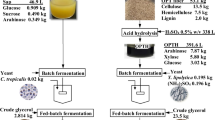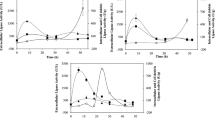Abstract
This study demonstrates the production of a generic nutrient-rich feedstock using by-product streams from palm oil production that could be used as a substitute for commercial fermentation supplements. Solid-state fermentations of palm kernel cake (PKC) and palm-pressed fiber (PPF) were conducted in tray bioreactors and a rotating drum bioreactor by the fungal strain Aspergillus oryzae for the production of crude enzymes. The production of protease was optimized (319.3 U/g) at an initial moisture content of 55 %, when PKC was used as the sole substrate. The highest free amino nitrogen (FAN) production (5.6 mg/g) obtained via PKC hydrolysis using the crude enzymes produced via solid-state fermentation was achieved at 50 °C. Three initial PKC concentrations (48.7, 73.7, and 98.7 g/L) were tested in hydrolysis experiments, leading to total Kjeldahl nitrogen to FAN conversion yields up to 27.9 %. Sequential solid-state fermentation followed by hydrolysis was carried out in the same rotating drum bioreactor, leading to the production of 136.7 U/g of protease activity during fermentation and 196.5 mg/L of FAN during hydrolysis. Microbial oil production was successfully achieved with the oleaginous yeast strain Lipomyces starkeyi DSM 70296 cultivated on the produced PKC hydrolysate mixed with commercial carbon sources, including glucose, xylose, mannose, galactose, and arabinose.






Similar content being viewed by others
References
USDA, United States Department of Agriculture (Foreign Agricultural Service) http://apps.fas.usda.gov/psdonline/psdquery.aspx (accessed 15.04.2016)
Yusoff, S. (2006). Renewable energy from palm oil–innovation on effective utilization of waste. Journal of Cleaner Production, 14, 87–93.
Basiron, Y., & Weng, C. K. (2004). The oil palm and its sustainability. Journal of Oil Palm Research, 16, 1–10.
Prasertsan, S., & Prasertsan, P. (1996). Biomass residues from palm oil mills in Thailand: an overview on quantity and potential usage. Biomass and Bioenergy, 11, 387–395.
Agunbiade, J. A., Wiseman, J., & Cole, D. J. A. (1999). Energy and nutrient use of palm kernels, palm kernel meal and palm kernel oil in diets for growing pigs. Animal Feed Science and Technology, 80, 165–181.
Mustaffa, B., Mizairi, S., & Hawari, H. (1991). Palm kernel cake in cattle feedlotting. Asean Food, 6, 102–103.
Tabi, A. N. M., Zakil, F. A., Fauzai, W. N. F. M., Ali, N., & Hassan, O. (2008). The usage of empty fruit bunch (EFB) and palm pressed fibre (PPF) as substrates for the cultivation of Pleurotus ostreatus. Jurnal Teknologi, 49, 189–196.
Jorgensen, H., Sanadi, A. R., Felby, C., Lange, N. E. K., Fischer, M., & Ernst, S. (2010). Production of ethanol and feed by high dry matter hydrolysis and fermentation of palm kernel press cake. Applied Biochemistry and Biotechnology, 161, 318–332.
Shukor, H., Abdeshahian, P., Al-Shorgani, N. K. N., Hamid, A. A., Rahman, N. A., & Kalil, M. S. (2016). Saccharification of polysaccharide content of palm kernel cake using enzymatic catalysis for production of biobutanol in acetone-butanol-ethanol fermentation. Bioresource Technology, 202, 206–213.
Zhu, Y., Xin, F., Zhao, Y., & Chang, Y. (2014). An integrative process of bioconversion of oil palm empty fruit bunch fiber to ethanol with on-site cellulase production. Bioprocess and Biosystems Engineering, 37(11), 2317–2324.
Thomas, L., Larroche, C., & Pandey, A. (2013). Current developments in solid-state fermentation. Biochemical Engineering Journal, 81, 146–161.
Abdeshahian, P., Samat, N., Hamid, A. A., & Yusoff, W. M. W. (2010). Utilization of palm kernel cake for production of β-mannanase by Aspergillus niger FTCC 5003 in solid substrate fermentation using an aerated column bioreactor. Journal of Industrial Microbiology and Biotechnology, 37(1), 103–109.
Sabu, A., Pandey, A., Daud, M. J., & Szakacs, G. (2005). Tamarind seed powder and palm kernel cake: two novel agro residues for the production of tannase under solid state fermentation by Aspergillus niger ATCC 16620. Bioresource Technology, 96(11), 1223–1228.
Couto, S. R., & Sanromán, M. Á. (2006). Application of solid-state fermentation to food industry-a review. Journal of Food Engineering, 76(3), 291–302.
Mienda, B. S., Idi, A., & Umar, A. (2011). Microbiological features of solid state fermentation and its applications—an overview. Research in Biotechnology, 2(6).
Tippkötter, N., Duwe, A. M., Wiesen, S., Sieker, T., & Ulber, R. (2014). Enzymatic hydrolysis of beech wood lignocellulose at high solid contents and its utilization as substrate for the production of biobutanol and dicarboxylic acids. Bioresource Technology, 167, 447–455.
Chutmanop, J., Chuichulcherm, S., Chisti, Y., & Srinophakun, P. (2008). Protease production by Aspergillus oryzae in solid-state fermentation using agroindustrial substrates. Journal of Chemical Technology and Biotechnology, 83(7), 1012–1018.
Oliveira, F. C., Freire, D. M. G., & Castilho, L. R. (2004). Production of poly (3-hydroxybutyrate) by solid-state fermentation with Ralstonia eutropha. Biotechnology Letters, 26(24), 1851–1855.
Cheirsilp, B., & Kitch, S. (2015). Solid state fermentation by cellulolytic oleaginous fungi for direct conversion of lignocellulosic biomass into lipids: fed-batch and repeated-batch fermentation. Industrial Crops and Products, 66, 73–80.
Tsakona, S., Kopsahelis, N., Chatzifragkou, A., Papanikolaou, S., Kookos, I. K., & Koutinas, A. A. (2014). Formulation of fermentation media from flour-rich waste streams for microbial lipid production by Lipomyces starkeyi. Journal of Biotechnology, 189, 36–45.
Leiva-Candia, D. E., Tsakona, S., Kopsahelis, N., García, I. L., Papanikolaou, S., Dorado, M. P., & Koutinas, A. A. (2015). Biorefining of by-product streams from sunflower-based biodiesel production plants for integrated synthesis of microbial oil and value-added co-products. Bioresource Technology, 190, 57–65.
Papanikolaou, S., & Aggelis, G. (2011). Lipids of oleaginous yeasts. Part I: biochemistry of single cell oil production. European Journal of Lipid Science and Technology, 113(8), 1031–1051.
Lin, J., Shen, H., Tan, H., Zhao, X., Wu, S., Hu, C., & Zhao, Z. K. (2011). Lipid production by Lipomyces starkeyi cells in glucose solution without auxiliary nutrients. Journal of Biotechnology, 152(4), 184–188.
Yu, X., Zheng, Y., Dorgan, K. M., & Chen, S. (2011). Oil production by oleaginous yeasts using the hydrolysate from pretreatment of wheat straw with dilute sulfuric acid. Bioresource Technology, 102(10), 6134–6140.
Yang, X., Jin, G., Gomg, Z., She, H., Song, Y., Bai, F., & Zhao, Z. K. (2014). Simultaneous utilization of glucose and mannose from spent yeast cell mass for lipid production by Lipomyces starkeyi. Bioresource Technology, 158, 383–387.
Anschau, A., Xavier, M. C. A., Hernalsteens, S., & Franco, T. T. (2014). Effect of feeding strategies on lipid production by Lipomyces starkeyi. Bioresource Technology, 157, 214–222.
Kachrimanidou, V., Kopsahelis, N., Chatzifragkou, A., Papanikolaou, S., Yanniotis, S., Kookos, I., & Koutinas, A. A. (2013). Utilisation of by-products from sunflower-based biodiesel production processes for the production of fermentation feedstock. Waste and Biomass Valorization, 4, 529–537.
American Association of Cereal Chemists Inc (AACC), 1983. Approved methods of the American Association of Cereal Chemists. 8th ed., St. Paul, MN, USA.
AOAC Official Method 973.18, fiber (acid detergent) and lignin (H2SO4) in animal feed, First Action 1973, Final Action 1977.
Lie, S. (1973). The EBC-ninhydrin method for determination of free alpha amino nitrogen. Journal of the Institute of Brewing, 79(1), 37–41.
Harland, B. F., & Harland, J. (1980). Fermentative reduction of phytate in rye, white and whole wheat breads. Cereal Chemistry, 57, 226–229.
Sundu, B., Kumar, A., & Dingle, J. (2006). Palm kernel mean in broiler diets: effect on chicken performance and health. World’s Poultry Science Journal, 62, 316–352.
Lawal, T. E., Iyayi, E. A., Adeniyi, B. A., & Adaramoye, O. A. (2010). Biodegradation of palm kernel cake with multienzyme complexes from fungi and its feeding value for broilers. International Journal of Poultry Science, 9(7), 695–701.
Ofori-Boateng, C., & Lee, K. T. (2013). Sustainable utilization of oil palm wastes for bioactive phytochemicals for the benefit of the oil palm and nutraceutical industries. Phytochemistry Reviews, 12, 173–190.
Ho, Y. W., Abdullah, N., & Jalaludin, S. (1991). Fungal colonization of rice straw and palm pres fibre in the rumen of cattle and buffalo. Animal Feed Science and Technology, 34, 311–321.
O’Mara, F. P., Mulligan, F. J., Cronin, E. J., Rath, M., & Caffrey, P. J. (1999). The nutritive value of palm kernel meal measured in vivo and using rumen fluid and enzymatic techniques. Livestock Production Science, 60(2), 305–316.
Koutinas, A. A., Vlysidis, A., Pleissner, D., Kopsahelis, N., Garcia, I. L., Kookos, I. K., Papanikolaou, S., Kwan, T. H., & Lin, C. S. K. (2014). Valorization of industrial waste and by-product streams via fermentation for the production of chemicals and biopolymers. Chemical Society Reviews, 43(8), 2587–2627.
Wang, R., Godoy, L. C., Shaarani, S., Melikoglu, M., Koutinas, A., & Webb, C. (2009). Improving wheat flour hydrolysis by an enzyme mixture from solid state fungal fermentation. Enzyme and Microbial Technology, 44(4), 223–228.
Wang, R., Shaarani, S., Md Godoy, L. C., Melikoglu, M., Vergara, C. S., Koutinas, A., & Webb, C. (2010). Bioconversion of rapeseed meal for the production of a generic microbial feedstock. Enzyme and Microbial Technology, 47, 77–83.
Sandhya, S., Sumantha, A., Szakacs, G., & Pandey, A. (2005). Comparative evaluation of neutral protease production by Aspergillus oryzae in submerged and soli-state fermentation. Process Biochemistry, 40, 2689–2694.
Battaglino, R. A., Huergo, M., Pilosof, A. M. R., & Bartholomai, G. B. (1991). Culture requirements for the production of protease by Aspergillus oryzae in solid state fermentation. Applied Microbiology and Biotechnology, 35(3), 292–296.
Koutinas, A., Wang, R. H., & Webb, C. (2005). Development of a process for the production of nutrient supplements for fermentations based on fungal autolysis. Enzyme and Microbial Technology, 36(5), 629–638.
Jorgensen, H., Kristensen, J. B., & Felby, C. (2007). Enzymatic conversion of lignocellulose into fermentable sugars: challenges and opportunities. Biofuels, Bioproducts and Biorefining, 1(2), 119–134.
Roche, C. M., Dibble, C. J., & Stickel, J. J. (2009). Laboratory-scale method for enzymatic saccharification of lignocellulosic biomass at high-solids loadings. Biotechnology for Biofuels, 2(1), 1.
Kiran, E. U., Salakkam, A., Trzcinski, A. P., Bakir, U., & Webb, C. (2012). Enhancing the value of nitrogen from rapeseed meal for microbial oil production. Enzyme and Microbial Technology, 50(6), 337–342.
Xavier, M. C., & Franco, T. T., 2014. Batch and continuous culture of hemicellulosic hydrolysate from sugarcane bagasse for lipids production. Chemical Engineering Transactions, 38.
Tapia, E., Anschau, A., Coradini, A. L., Franco, T. T., & Deckmann, A. C. (2012). Optimization of lipid production by the oleaginous yeast Lipomyces starkeyi by random mutagenesis coupled to cerulenin screening. AMB Express, 2(1), 1–8.
Anschau, A., & Franco, T. T. (2015). Cell mass energetic yields of fed-batch culture by Lipomyces starkeyi. Bioprocess and Biosystems Engineering, 38(8), 1517–1525.
Koutinas, A. A., Wang, R., & Webb, C. (2004). Restructuring upstream bioprocessing: technological and economical aspects for production of a generic microbial feedstock from wheat. Biotechnology and Bioengineering, 85, 524–538.
Acknowledgments
The work presented in this study has been funded by ANP, Petrobras (Brazil), and the National Council for Scientific and Technological Development of the Ministry of Science, Technology and Innovation (CNPq/MCTI) through the Special Visiting Researcher fellowship (process number: 313772/2013-4).
Author information
Authors and Affiliations
Corresponding authors
Additional information
Maria Guimarães Freire and Apostolis A. Koutinas contributed equally as corresponding authors.
Rights and permissions
About this article
Cite this article
Tsouko, E., Kachrimanidou, V., dos Santos, A. et al. Valorization of By-Products from Palm Oil Mills for the Production of Generic Fermentation Media for Microbial Oil Synthesis. Appl Biochem Biotechnol 181, 1241–1256 (2017). https://doi.org/10.1007/s12010-016-2281-7
Received:
Accepted:
Published:
Issue Date:
DOI: https://doi.org/10.1007/s12010-016-2281-7




